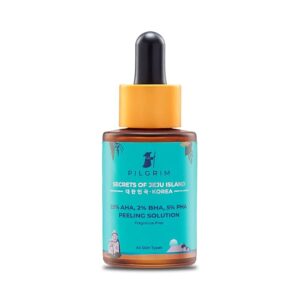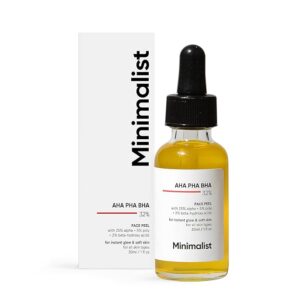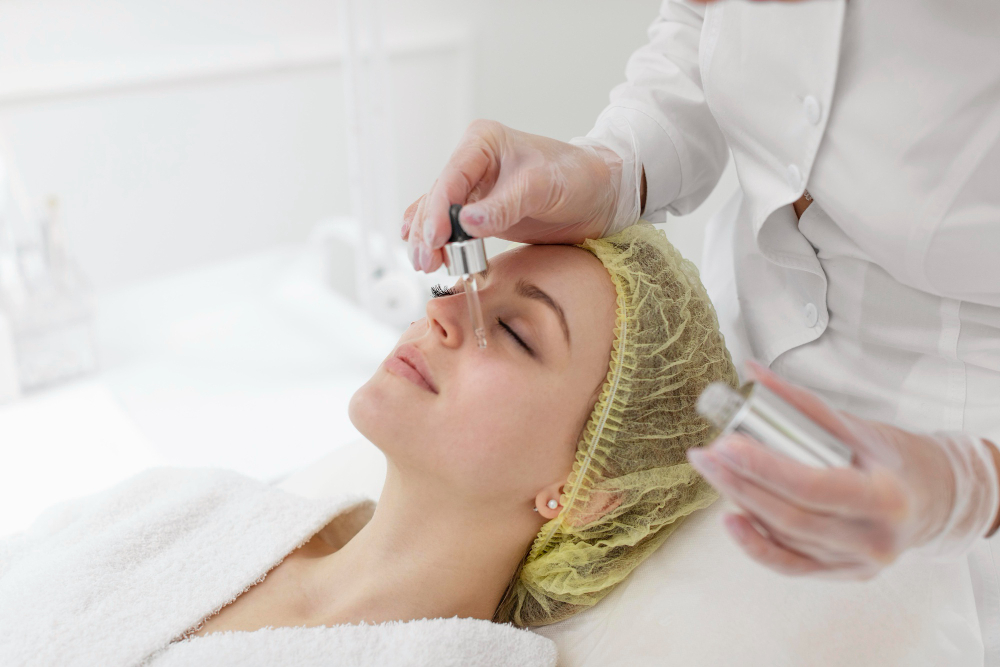/IN THIS ARTICLE
♥ How Often Can I Use a Glycolic Acid Peel?
♥ What Is a Glycolic Acid Peel?
♥ How Strong Are Home Glycolic Acid Peels?
♥ Weekly or Less: The Ideal Frequency
♥ What Takes Place When Glycolic Acid Peels Are Overused?
♥ How to Build Up Your Skin’s Tolerance
♥ When to Skip a Glycolic Acid Peel
♥ Post-Peel Care: Protecting Your Skin
♥ Best Glycolic Acid Peels
♥ How to Do a Glycolic Acid Peel at Home: Step-through-Step Guide for Radiant Skin
♥ Final Thoughts
♥ FAQ
How Often Can I Use a Glycolic Acid Peel?
Glycolic acid peel have become a go-to for skin care enthusiasts who need a greater radiant, refreshed complexion. But, like something that works wonders, it’s essential to realize how regularly you could competently use them—specifically while you’re doing it at domestic. So, in case you’ve got your hands on this sort of famous peel, let’s communicate about how regularly you should be making use of it and what you want to look out for.
What Is a Glycolic Acid Peel?
Before we dive into how regularly you may use it, let’s speedy cowl what a glycolic acid peel is. Glycolic acid, an alpha hydroxy acid (AHA), is understood for its ability to exfoliate the skin by way of breaking down the lifeless skin cells on the surface. This system can display more energizing, smoother skin underneath, supporting to reduce the arrival of nice lines, darkish spots, and different imperfections.
How Strong Are Home Glycolic Acid Peels?
One component to keep in thoughts is that glycolic acid peels you use at home normally have a better concentration of AHA as compared to what’s discovered for your everyday skincare merchandise. We’re speaking everywhere from 10% to 30% glycolic acid in these home treatments, this means that you need to be a little greater cautious.
It’s not something you slap on every night—that is a treatment that calls for a chunk of strategy.
Weekly or Less: The Ideal Frequency
For most human beings, using a glycolic acid peel as soon as every week is a lot. This offers your skin sufficient time to acquire the advantages of exfoliation at the same time as fending off the hazard of inflammation or dryness that may come from overuse. Some products even recommend a much less frequent schedule, so constantly take a look at the commands that include the specific peel you’re the use of. If it’s your first time attempting a glycolic peel, it’s better to start gradually and gauge how your skin reacts.
What Takes Place When Glycolic Acid Peels Are Overused?
Glycolic acid peels, when done correctly, can leave your skin looking radiant and dazzling. But overuse can have the opposite effect. Applying a peel too frequently can cause redness, infection, dryness, or even breakouts. The goal is to improve your pores and skin, no longer strip it down, so face up to the urge to apply it too frequently.
How to Build Up Your Skin’s Tolerance
If you’re new to glycolic acid or have sensitive skin, you might need to ease into it. Start by using the use of the peel as soon as each week and screen how your skin responds. If matters are searching good—no excessive redness or dryness—you may step by step boost the frequency to weekly.
When to Skip a Glycolic Acid Peel
There are instances whilst you might want to hold off on using your glycolic acid peel, despite the fact that it’s a part of your ordinary habitual. For instance, in case your pores and skin are feeling more dry, angry, or touchy from different remedies, supply it a ruin. Also, if you’ve had the latest solar exposure or a sunburn, wait till your pores and skin have fully healed earlier than reaching for the peel.
Post-Peel Care: Protecting Your Skin
After you’ve used a glycolic acid peel, your pores, and skin are going to be a piece more sensitive than normal. Make certain you’re following up with an amazing moisturizer and sunscreen. Your skin barrier desires a little greater love after exfoliating, and solar protection is key because your pores and skin are extra at risk of UV harm after a peel.
Best Glycolic Acid Peel :-
1. Pilgrim 25% AHA + 2% BHA + 5% PHA Peeling Solution for Face.
Pros:-
Suitable for Men and Women: The product is designed for all skin sorts and genders, making it versatile.
Cons:-
Not Suitable for Beginners: If you are new to chemical exfoliants, the power of this product may be too severe, requiring cautious tracking and slow introduction.
API – glycolic acid, salicylic acid, hyaluronic acid, lactic acid
Skin Type – All
Shop Now : AMAZON

2.Minimalist 25% AHA + 2% BHA + 5% PHA Peeling Solution.
Pros:-
At-home Professional Peeling: The product gives a professional-grade exfoliation that can be used at domestic, saving time and cost on salon treatments.
Cons:-
Limited Size (30ml): The bottle is small (30ml), which might not close long if used always, mainly for regular exfoliation.
API – Glycolic Acid, Salicylic Acid
Skin Type – All, Sensitive, Dry, Normal, Oily
Shop Now: AMAZON

How to Do a Glycolic Acid Peel at Home: Step-through-Step Guide for Radiant Skin
So, you are thinking about doing a glycolic acid peel at home? Great preference! It’s one of the exceptional ways to rejuvenate your skin without spending a fortune on the spa. But let’s be actual—this isn’t a process you want to wing. Your pores and skin merit a few TLC, and that starts with a stable plan. Let’s break all of it down, grade by grade, so you can glow like a pro.
Step 1: Make a Plan for Your Peel
Before diving headfirst into the world of peels, take a moment to prepare. Trust me, this step is important—mainly if it’s your first time.
Pick the Right Time
Peels can make your skin purple, smooth, and a touch-sensitive. You don’t want to schedule a peel the day earlier than a huge occasion or an assembly wherein you want to be digital camera-equipped. Ideally, plan your peel for a time while you could live low-key for a few days.
Here’s a pro tip: Do your peel on a Friday night. In that manner, your skin receives Friday night, Saturday, and Sunday to get better. By Monday, you’ll be equipped to face the world—literally!
Pause Prescription Products
If you’re using prescription zit remedies, hit the pause button two to three days before your peel. Ingredients like benzoyl peroxide, retinoids, and salicylic acid can make your skin more sensitive, and the remaining element you need is an overreaction.
I’m not certain if your product is a no-cross. Check the label for the one’s energetic components. If they’re indexed, set them aside for some days before and after your peel.
Switch to a Gentle Cleanser
Opt for a soap-free cleanser main up to your peel. This facilitates prepping your pores and skin without over-drying or disturbing it. The purpose is to start with a relaxed, easy canvas.
Stock Up on Post-Peel Essentials
Once the peel is on, you don’t have time to run around collecting substances. Be prepared! Here’s your need-to-have listing:
- A slight cleaner (soap-free works notable)
- A gentle cloth for cool compresses
- Aloe vera or a soothing mask
- A lightweight moisturizer
- Broad-spectrum sunscreen
Step 2: Applying the Glycolic Acid Peel
Alright, now it’s showtime. Applying the peel would possibly sound intimidating, but in case you observe those steps, you’ll nail it.
Buy from a Trusted Source
Start with a reputable vendor. Whether it’s a glycolic acid peel package or an unmarried product, make sure it’s reliable. Read evaluations, take a look at the concentration (typically 20-30% for novices), and keep away from anything sketchy.
Prep Your Skin
Before applying the peel, use a prep answer. Most kits include one, however you may DIY it with witch hazel or diluted rubbing alcohol. Dab it on your face with a cotton ball to dispose of oils and create a smooth base for the acid.
Cover your whole face frivolously. If you want a 2nd cotton ball, move for it. The goal is thorough insurance.
Let Your Skin Dry Completely
Once you’ve carried out the prep answer, allow your skin to dry for approximately 10 mins. Seriously, don’t rush this. A dry face guarantees even software and allows for avoiding irritation.
Pro tip: Apply petroleum jelly to touchy regions just like the corners of your lips, nostrils, and around your eyes. This creates a barrier and protects these delicate spots.
Use a Fan Brush for Application
Grab a clean fan brush—no make-up residue, please—and dip it into the glycolic acid. Apply the acid evenly throughout your face, fending off sensitive areas. You might need to reload the brush a few times to cover your entire face.
Limit the Time
For first-timers, preserve the acid for no a couple of minutes. You’ll feel a little tingling—that’s ordinary. But if it starts to burn, rinse it off right now with cool water. No one wants to change destructive their skin.
Neutralize the Acid
After the minute is up, it’s time to forestall the acid from operating. Most kits include a neutralizing answer, however plain water or a mild purifier works too. Splash it on your face, rinse thoroughly, and pat dry. Avoid rubbing, as your pores and skin might be extra sensitive.
Step 3: Caring for Your Skin Post-Peel
Congrats, you’ve made it thru the peel! Now comes the all-essential aftercare. This is where the real magic takes place.
Soothe with Cooling Products
Your pores and skin may feel like it’s had a bit too much solar. To calm things down, observe a cooling product like aloe vera gel or lay a cold, damp material over your face. Instant remedy!
Moisturize, Moisturize, Moisturize
Glycolic acid can dry out your pores and skin, so don’t bypass this step. Use a lightweight, fragrance-free moisturizer to repair hydration. Slather it on generously—you sincerely can’t overdo it.
If your skin starts to peel, withstand the urge to look at it. Instead, follow more moisturizer and allow the useless skin to flake off clearly. Trust me, forcing it off can result in infection or even scarring.
Stay Out of the Sun
Your skin is brilliantly touchy after a peel, so sun protection is non-negotiable. Avoid direct daylight for a few days, and in case you must go outside, use a wide-spectrum sunscreen with SPF 30 or higher. Hats and sun shades are your first-class friends, specifically between 10 AM and a pair of PM when the solar is strongest.
Final Thoughts
Doing a glycolic acid peel at domestic may be a sport-changer on your pores and skin, but it’s all about guidance, precision, and aftercare. Follow those steps, and also you’ll be on your way to brighter, smoother, and greater radiant pores and skin. Happy peeling!
FAQ:-
1. Can I use a glycolic acid peel if I even have sensitive skin?
- Yes, however with caution. Start with very low concentrations (5-10%) and use much less often to avoid inflammation.
- It’s fine to consult a dermatologist before the use of glycolic acid on touchy skin.
2. How long does it take to look effects of a glycolic acid peel?
- Initial improvements like smoother texture and brighter pores and skin may be visible after a few makes use of, however, for sizeable outcomes (e.g., reducing first-class lines or hyperpigmentation), it can take numerous weeks of steady use.
3. How does glycolic acid help enhance pores and skin texture and tone?
- By removing useless skin cells and encouraging new cellular boom, glycolic acid peels enhance the overall texture and tone, making the skin appear smoother and more even.
- Over time, in addition, they help fade hyperpigmentation, dark spots, and solar damage.
4. Can glycolic acid peels be used on the body, or simply the face?
- Glycolic acid peels can be used on the body, especially in regions with tough pores and skin just as the elbows, knees, and back. However, the face remains the most commonplace treatment region.
- Use decreased concentrations for frame treatments, as frame pores and skin can occasionally be extra touchy.
Also Read this article: Glycolic Acid Toner: The Secret to Radiant, Clear Skin



Leave a Reply